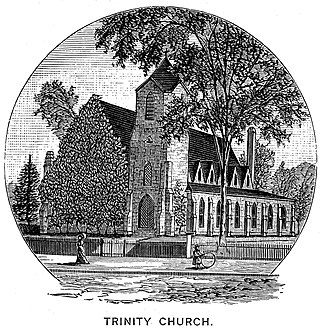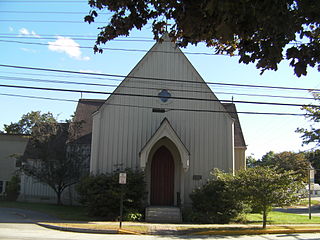
Richard Upjohn was a British-born American architect who emigrated to the United States and became most famous for his Gothic Revival churches. He was partially responsible for launching the movement to popularity in the United States. Upjohn also did extensive work in and helped to popularize the Italianate style. He was a founder and the first president of the American Institute of Architects. His son, Richard Michell Upjohn, (1828-1903), was also a well-known architect and served as a partner in his continued architectural firm in New York.

Carpenter Gothic, also sometimes called Carpenter's Gothic or Rural Gothic, is a North American architectural style-designation for an application of Gothic Revival architectural detailing and picturesque massing applied to wooden structures built by house-carpenters. The abundance of North American timber and the carpenter-built vernacular architectures based upon it made a picturesque improvisation upon Gothic a natural evolution. Carpenter Gothic improvises upon features that were carved in stone in authentic Gothic architecture, whether original or in more scholarly revival styles; however, in the absence of the restraining influence of genuine Gothic structures, the style was freed to improvise and emphasize charm and quaintness rather than fidelity to received models. The genre received its impetus from the publication by Alexander Jackson Davis of Rural Residences and from detailed plans and elevations in publications by Andrew Jackson Downing.

Gloria Dei Church, known locally as Old Swedes', is a historic church located in the Southwark neighborhood of Philadelphia, Pennsylvania, at 929 South Water Street, bounded by Christian Street on the north, South Christopher Columbus Boulevard on the east, and Washington Avenue on the south. It was built between 1698 and 1700, making it the oldest church in Pennsylvania and second oldest Swedish church in the United States after Holy Trinity Church in Wilmington, Delaware.

The Episcopal Diocese of Rhode Island is a diocese of the Episcopal Church in the United States of America, encompassing the state of Rhode Island. It is one of seven New England dioceses that make up Province 1.

The Church of the Holy Trinity is an historic Episcopal church at 381 Main Street in Middletown, Connecticut. Completed in 1874, it is one of the city's finest examples of Gothic Revival architecture. Its nearby former rectory, also known as the Bishop Acheson House, is one of its finest Colonial Revival houses. The two buildings were listed on the National Register of Historic Places in 1979.

Russell Warren (1783–1860) was an American architect, best known for his work in the Greek Revival style. He practiced in Bristol and Providence.
Edward Tuckerman Potter was an American architect best known for designing the 1871 Mark Twain House in Hartford, Connecticut. With his half-brother William Appleton Potter, he also designed Nott Memorial Hall (1858–79) at his alma mater, Union College, Schenectady, New York. Both the Mark Twain House and Nott Memorial Hall are National Historic Landmarks.

Trinity Church, on Queen Anne Square in Newport, Rhode Island, is a historic parish church in the Episcopal Diocese of Rhode Island. Founded in 1698, it is the oldest Episcopal parish in the state. In the mid 18th century, the church was home to the largest Anglican congregation in New England.

S. Stephen's Church is an historic Episcopal church located at 114 George Street in the College Hill neighborhood of Providence, Rhode Island. Located in the midst of the Brown University campus, it is an active parish in the Episcopal Diocese of Rhode Island, with a strong Anglo-Catholic identity.

Grace Church is an historic Episcopal church at 300 Westminster Street at Mathewson Street in downtown Providence, Rhode Island. It was built in 1845-46 and was designed by Richard Upjohn in the Gothic Revival style.

Trinity Episcopal Church was a historic church located at 48 Main Street in Pawtucket, Rhode Island. Built by the Episcopalians, the building was sold to the Catholics in 1977 and became the St. George Maronite Catholic Church within the Diocese of Providence. The church burned down in 2005, and was not rebuilt.

The Episcopal Cathedral of St. John, located at 271 North Main Street in Providence, Rhode Island was built in 1810 and was designed and built by John Holden Greene in the early Gothic Revival style, replacing a smaller wooden 1722 church on the same site. A chapel by Richard Upjohn was added in 1856, and the south transept by Clifton A. Hall in 1866. The interior was remodeled by Cram, Goodhue & Ferguson in the Baroque style in 1905, and further changes were made in 1967. The Diocesan Offices next door was designed by Milman & Sturges in 1967, and changes were made to it in 1972. The church was made a seat of the Episcopal Diocese of Rhode Island in 1929.

St. Paul's Episcopal Church is a historic church at 27 Pleasant Street in Brunswick, Maine. Built in 1845, it is a distinctive early example of a modest Carpenter Gothic design by Richard Upjohn, then already well known for his larger-scale Gothic churches. The building was listed on the National Register of Historic Places in 1978. The rector is Rev. Carolyn H. Eklund.

Trinity Episcopal Church is a parish church in the Episcopal Diocese of Iowa. The church is located in Iowa City, Iowa, United States. It was individually listed on the National Register of Historic Places in 1974. In 2021, the building was included as a contributing property in the Iowa City Downtown Historic District.
Clement Weaver, also known as Clement Weaver Jr. and Sergeant Clement Weaver, was a member of the House of Deputies of the Colony of Rhode Island and Providence Plantations in 1678, one of the founders of East Greenwich, and the immigrant ancestor of thousands of Weaver descendants in the United States. Clement Weaver and his ancestry and descendants are the subject of a 740-page volume, History and Genealogy of a Branch of the Weaver Family, published in 1928.
Edward Patrick Denning (1926–2003) was an American architect from East Providence, Rhode Island. He was a well-known architect of public buildings and churches in 1960s and 1970s Rhode Island.
Frederic Rhinelander King, was an American architect, and the co-founder with Marion Sims Wyeth of the architecture firm Wyeth and King.

Zion Episcopal Church is a historic Episcopal parish church founded in 1847 in Talbotton, Georgia, the county seat of Talbot County. It is a fine and unusual example of the English Tudor and carpenter-gothic style, influenced by Richard Upjohn, in a rural southern setting. The church was funded by wealthy planters from coastal Georgia and South Carolina who had created an unusually affluent community on the southern frontier by settling together in the forested piedmont of the Chattahoochee Valley –formerly remote Muscogee-Creek territory. The church today, although lacking a regular congregation, is maintained as a chapel by St. Nicholas Episcopal Church in nearby Hamilton, which hosts services in the space regularly.
Oliver Sherman Prescott was a prominent American Anglo-Catholic priest and activist who was active in the foundation of the Society of St. John the Evangelist. He was born in New Haven, Connecticut, and baptized by Harry Croswell at Trinity Church on the Green in that city. Prescott attended Trinity College, Hartford from 1840 to 1842 and Yale College from 1843 to 1844; he was graduated from the General Theological Seminary in New York in 1847 and made a deacon that year at Trinity Church in New Haven. He considered himself a protégé at the General of Professor Clement Clarke Moore.
The Sisterhood of the Holy Nativity (SHN) is an Anglican religious order for women founded in 1882 by Charles Chapman Grafton SSJE. Three sisters and six novices of the Society of St. Margaret (SSM), associated with the Cowley Fathers, left SSM in 1882 to establish the new order. Sister Ruth Margaret Vose (1826-1910) was its first mother superior. The order was incorporated in Wisconsin on May 29, 1921, and remains active in the Episcopal Diocese of Fond du Lac.















